|
By BrianL - 16 Years Ago
|
|
For my otherwise stock '56 312, I now have the later dizzy installed & bought a ECZ-9425-B intake that I plan on installing next week. I have been searching the forum for anything related to carb preferences, issues, & tuning. I plan on a very mild rebuild in the future, slightly hotter cam, headers, nothing too fancy. I'll never race it, just want a fun weekend nice weather cruiser with good drivability & a bit better performance. So I see many have good experience with the Holley 390, Demon Jr 525, & the Edlebrock 500's. Opinions vary of course, but generally I am seeing positive results with these. Should I worry that I will outgrow the 390 & wish I would have gone with one of the others? The Demon Jr gets a lot of praise, but I also see some saying they needed to modify the vacuum port for proper distributor advance & also will need to hog out the B intake to match the large carb throats. That sounds a bit scary. Also I worry the Demon Jr being so physically large it wont fit under my T-Bird hood. Those of you that have been down this path before, if you had to do it again, what would be your choice? For rebuilt carbs, the price differences don't appear to be a huge difference. E'brocks could save me some, but not if it isn't the right choice. I am thinking electric choke & block off the intake's center exhaust passageway with thin sheet metal. I value your thoughts!
|
|
By 55vickey - 16 Years Ago
|
|
I'm running a 465 Holley, and it is a really nice, quite simple carb. 272, large valves, later dizzy, Pertronix ignition. Doesn't seem to be to much carb. Gary
|
|
By oldcarmark - 16 Years Ago
|
|
As you know I have the 390 Holley on mine but its only going to be a stock motor.The 465 is a step up and shouldnt be a problem.I put a little piece of tin to cover the exhaust croosover on mine.Worked fine.I also put a 1 inch phenolic spacer under the carb but I understand T-Birds have not as much clearance under the hood.You may have to go to 1/2 inch.
|
|
By paul2748 - 16 Years Ago
|
|
I'm running a stock Holley on my 56 TBird and 3 x2's in my 54 so i can't help out on a YBlock. But I run a 600 Edelbrock on my slightly modifed 302 in my 48. I have never had a problem with the Edelbrock in the some 15 years I have run the carb. It ran good right out of the box. I had it professionally rebuilt about two years ago because I had some problems with the way the car was running. Turns out the problem was not the carb and the rebuilder told me the carb was in excellent condition (after charging me $150).
|
|
By Gordie T - 16 Years Ago
|
Brian
Seems like you're in the same boat as me...I am going to buy a 500 cfm carb I guess because I can't find someone who wants to up jump to a 600 cfm...and trade with me.
I have an Edelbrock 1406, 600 cfm electric choke carb that is too large for my 272. Once I put the engine back in my Fairlane and get her running I'll probably order a smaller Edelbrock. The Autolite I've mentioned in other posts, which is on ebay is too much in my book for the gamble of it not working right.
What I'm saying is my Edelbrock will be available if you want it soon. It may be just what your 312 needs.
Cheers
Gord
|
|
By rgrove - 16 Years Ago
|
|
I have run a holley 390 and an edelbrock 500 on my 292 (little bigger cam, FOM). Here are my thoughts: 390 - goo dcarb, easy to adjust, had a n assy defect new out of the box that was a bugger to track down. Once sorted out, it provided good throttle response, and started very easily - much easier than the edelbrock, especially after sitting for a few days. 500 - Carb is good, but feels a little "sloppy"... by that i mean the throttle response isnt as crisp as the 390. However, carb pulls noticeably harder at WOT. The 390 feels like it runs out of breath quickly, but the 500 pulls much harder through the rev range. Both carbs required a bit of tuning for my application, both are pretty easy to tune. after running both carbs back to back over several days, the decision to stay with the edelbrock was pretty easy...just plain ole more power, but the 390 worked well. I think a 600 would be too big (and the math says so too). Ill probably sell the 390 and try a Road Demon Jr 525. Rumor has it they have very good throttle response compared to the edelbrock......not sure how much bigger they are than the holley or edelbrock though... Let me know if you need any other info. Also, you can get intake manifold gaskets with the exhaust heat passage mostly blocked off - those work fine too to keep the paint on the manifold.
|
|
By BrianL - 16 Years Ago
|
|
rgrove - bu tuning on the Edlebrock 500, was that changing the primary jets or what? I am leaning towards that one at the ,moment, but any tuning advice would ve valuable to know as well. The Demon jr sounds like agreat carb too. I'm just worried about having to hog out the manifold bores to match the large carb primaries & also I have heard they are physically very large. I want my T-Bird hood to close! I also hear with the large primaries & a Ford-O-matic, second gear starts are somewhat difficult. Anyone with direct experience with this carb on a 312 T-Bird?
|
|
By shakey pete - 16 Years Ago
|
Hi merry xmas to all as far as carb,s are concerned I think that a holley is the way to go the y blk cann,t handel a big carb they don,t have the breathing that a chev has and a holley you can tune it to fit your engine I tried a 6oocfm holley on my 312 and it was to much carb. blk soot out the tail pipe, went to a 390 or 450 holley and it ran great anything you want for a holley to fine tune it you can get it an anybody with half a brain can tune it 
|
|
By Pete 55Tbird - 16 Years Ago
|
|
Brian I have a 1955 Tbird with an aircooled FOM and a 1957 312 engine. I have used a Holley 1850 AAS ( 600 CFM, vacuum secondaries ) for over 25 years and have never thought of changing it for something else. I did add the electric choke. You are right to wonder if you get the 390 or 465 if you may regret it as you probably will. The vacuum secondary carb is self regulating in that the airflow through the venturies draws the amount of fuel out of the fuel bowl that it needs. That makes it very forgiving and docile in normal driving. Most of the time you are only using it as a TWO BARELL carb in normal everyday driving. Then you want to go fast and you stand on it. At this point you are still on two barrels until your engine RPM and manifold vacuum cause the second two barrels to open and add power. Ask yourself do you want a 390 or a 465 or a 600? Let us know what you decide and if your happy with whatever you choose. Pete
|
|
By charliemccraney - 16 Years Ago
|
|
BrianL (12/26/2009)
rgrove - bu tuning on the Edlebrock 500, was that changing the primary jets or what? I am leaning towards that one at the ,moment, but any tuning advice would ve valuable to know as well.
The Demon jr sounds like agreat carb too. I'm just worried about having to hog out the manifold bores to match the large carb primaries & also I have heard they are physically very large. I want my T-Bird hood to close! I also hear with the large primaries & a Ford-O-matic, second gear starts are somewhat difficult. Anyone with direct experience with this carb on a 312 T-Bird?
Tuning an Edelbrock usually consists of changing metering rods and/or jets, and/or step-up springs. The manual that comes with Edelbrock carbs is pretty good. It goes over the theory of carburetor operation, and tuning.
I agree with Rgrove about the performance of the Edelbrock. I changed to a Holley 570 from an Edelbrock 600. The throttle response of the Holley is much more crisp. And since I've owned a Holley, I find that it is easier to tune than the Edelbrock - I had always heard the opposite. The Holley is also simply more tunable.
I believe that the only carb that will not be a mismatch to the intake is the Holley 390. You can use an alternative that Steve presented and taper a carburetor spacer, rather than grinding on the intake.
http://www.y-blocksforever.com/forums/Topic21823-3-1.aspx
Either way you do it, you don't want a step in the transition.
I'd go with Holley or a Demon. Since I've not yet used a Demon, the next time I need a carb it will be one of them, just to see what they're like.
|
|
By pegleg - 16 Years Ago
|
Pete 55Tbird (12/26/2009)
Brian Most of the time you are only using it as a TWO BARELL carb in normal everyday driving. Then you want to go fast and you stand on it. At this point you are still on two barrels until your engine RPM and manifold vacuum cause the second two barrels to open and add power. Ask yourself do you want a 390 or a 465 or a 600? Let us know what you decide and if your happy with whatever you choose. Pete Pete you are right.....but there's a catch. With a smaller engine, 272 or 292, you'll want a carb with small primary venturii's for better throttle response and mileage at the lower RPM's and Throttle openings you use on the street. the 390's and 465's have those. you'll only need the 600 cfm part at full throttle and higher revs. Maybe someday Ted or John will get a chance to do back to back carb tests on a mild 292/312. It would be an interesting duno run.
|
|
By 'GB'ird - 16 Years Ago
|
|
I seem to remember there's a rough calculation to determine the CFM requirement for a carb. I believe it's cubic inch X max revs/3456 but I'm sure there's others out there who can confirm this. So a 312ci @ (say)4500rpm divided by 3456 = a requirement of about 400 CFM. I guess this is pretty rough but should be a fair guide for a basically stock engine. Cheers Richard
|
|
By Ted - 16 Years Ago
|
|
I’ve a low opinion for those carb calcs as internal circuitry on a particular carb makes all the difference. I’m currently in the process of dynoing a 312 that has unported G heads with a multitude of carbs on a variety of intakes including a dead stock intake with the original ½” spacer. Fifteen different carbs have so far been tested. The best overall players so far are a pair of 600 Holleys and a L1848 465cfm Holley. The original L1273 (ECZ) Holley (410cfm?) and the original ECZ-AA Carter (400cfm) were the worst of the lot. The star of the show on the stock intake is the 1.08 Ford (480cfm) and while it was down on upper end horsepower, the lower end torque numbers were out of sight. An 830cfm vacuum secondary Holley was also tried on the stock intake and was found to perform the same as the 600’s on this particular engine while idling characteristics and low end reponse were just fine. The problem with all this testing is it’s primarily associated to this particuar engine combination and as head porting and better intake manifolds come into play later, much of what’s learned here may not be very applicable. What makes vacuum secondary carbs very nice to work with is that engine demand will only permit the secondaries to open by the amount that the engine wants if the carb is properly tuned. It's difficult to overcarb an engine with a correctly tuned vacuum secondary carb but selecting the correct size double pumper carb is difficult in this regard.
|
|
By pegleg - 16 Years Ago
|
|
Ted, have you had a chance to see how one of the Demons stacks up?
|
|
By 2DRHRDTP57 - 16 Years Ago
|
|
I have to agree with Ted on this one, although now on my rebuilt 309 Y Block I am considering the 525 Jr. The Old original 4100 1.08 Autolite ran the best and to me had the most power on my Original 292, She never pulled big numbers but as far as drivability and power the Autolite performed better than the Holleys I played with, 390 and 500 CFM models. I also ran a 1.12 off the FE 352 from our Ranchero performed well on the FE, but the 1.08 performed better than the 1.12 4100. They must still have a cult following coz they still pull good money for the 4100 carbys.
|
|
By Ted - 16 Years Ago
|
|
pegleg (12/27/2009)
Ted, have you had a chance to see how one of the Demons stacks up? Have not tried any Demon carbs yet. My 525 cfm Road Demon Jr. is on my ’55 right now which is sitting at the paint shop. Although the ‘55 was suppose to be ready last week, I’m still waiting for it. As soon as I get the car back, I’ll run that carb also along with what I’m considering the baseline carbs for the next series of testing. The 650 vacuum secondary Speed Demon that's sitting here will get run this week though while the stock intake is still on the engine.
|
|
By marvh - 16 Years Ago
|
Ted:
What was the stamping numbers on the Autolite 1.08 you were testing.
It will be on the the drivers side front foot. It should be C###-#
I have found the C6PF 1.08 carbs the best of the 1.08 size. These were the over the counter replacement carb and last models built.
marv
|
|
By Ol'ford nut - 16 Years Ago
|
|
I just bought a Holley 465 for my 56 and was wondering if there was any reason why I couldn't hook the electric choke wire to the positive wire for the coil.
|
|
By Nick Brann - 16 Years Ago
|
|
Hi Ol'ford, I'm running a Carter AFB with electric choke on my '57. I ran the wire for the electric choke off of the input (12V) side of the ignition coil resistor. It has worked fine for the past three years or so. It is recommended that you put a fuse in the wire to the choke, on mine I guessed and went with a 3 amp fuse. So far so good. Nick Brann, K.C., MO
|
|
By BrianL - 16 Years Ago
|
|
So after reading all the reply's, & searching the site, I decided on the Demon Jr 525. Lots of good comments & I don't want to regret going too small with the 390 later. I will attempt to resize the B intake ports & hope I don't screw that one up. In searching anything to do with this carb, I don't see much mentioned with having to change jetting or secondary springs on the Demon Jr. Anyone with personal experience with the need for tuning out of the box Demon Jr?
|
|
By PF Arcand - 16 Years Ago
|
|
Ted: On your carburetor test engine, those are interesting test results. For reference purposes, what cam does it have & is the compression near stock? Thanks
|
|
By Ted - 16 Years Ago
|
|
Ol'ford nut (12/28/2009)
I just bought a Holley 465 for my 56 and was wondering if there was any reason why I couldn't hook the electric choke wire to the positive wire for the coil.Hooking the choke up to the coil or anywhere in the ignition circuit is typically not recommended due to making for a voltage drop at the coil. If running an electronic conversion in the distributor, this can cause a premature failure of the module or at the very least, just hard to start.
|
|
By Ted - 16 Years Ago
|
|
marvh (12/28/2009)
Ted:
What was the stamping numbers on the Autolite 1.08 you were testing.
It will be on the the drivers side front foot. It should be C###-# The stamped numbers on base of the 1.08” carb I’m using for testing is “6Z P” while the jet sizes are 47 primary & 57 secondary. The original tag on top is gone. This was the only 1.08” carb sitting here that was in a runable condition but idles and runs well.
|
|
By Ted - 16 Years Ago
|
|
BrianL (12/28/2009)
....In searching anything to do with this carb, I don't see much mentioned with having to change jetting or secondary springs on the Demon Jr. Anyone with personal experience with the need for tuning out of the box Demon Jr?The Road Demon Jr. on my ’55 with its 272 is using a pair of 61 jets on the primary side instead of the factory installed 58’s. My particular engine combination just drives better being jetted this way. I also modified the ported vacuum circuit to provide a stronger vacuum signal for the distributor for an increase in ignition advance during cruise situations.
|
|
By Ted - 16 Years Ago
|
|
PF Arcand (12/29/2009)
Ted: On your carburetor test engine, those are interesting test results. For reference purposes, what cam does it have & is the compression near stock? ThanksThe engine is +060 over and the pistons are 0.025” in the hole. The static compression ratio is a real 9.2:1 while the camshaft is a Crower Monarch grind with the duration being 238° at 0.050” and advertised 0.450” lift. The actual lift at the valve measures right at 0.400” with aftermarket replacement rockers that are currently being used. I’ll eventually get around to testing the various oem rockers ratios as well as the Thomas, Dove, Rocker Arm Specialist, and Harland Sharp rockers that are sitting here. A serious header test is still in the works also. Those stock heads are not being very responsive to changes though so I may end up changing heads in the near future to get some more definitive results on what the different intake manifolds are really worth. Head flow is currently the bottleneck for increasing the performance on this particular engine.
|
|
By Philo - 16 Years Ago
|
This is a great topic.
Back in '67 I had a stock displacement 312 in my '48 Tudor. The only mods it had were a B7A-C cam, a Mallory dual point conversion and Hedman T-Bird tri-y headers. T-10 transmission and 4.57 open 9" rear end.
I found a 715 CFM Holley from a Shelby GT 350 for cheap and bolted it on with 2 stock spacers.
My good friend had a '62 406 4v 4 speed Galaxy 2 dr. We took our cars to Dragway 42 one Sunday for kicks. We were able to line up together for one run.....I WON! Couldn't believe it! My et was 15.24, I don't remember the mph. We were both on street tires. Anyhow my car really ran good with that carb. Back then we did a lot of street racing and it was a thrill to beat GTOs and an occasional 442 with that old hot rod! It seems to me that Y blocks like to be over carburated a tad. It's great that Ted is doing this dyno testing.
P.S. I loaned that carb to that same friend and never got it back. I wish I had it now!
|
|
By 62galxe - 16 Years Ago
|
|
sounds like you got the right carb Ted. from my research the Z in the 6Z-P would be 289 mustang. Mine is 6A-E and A is full size car with 390. suppose to have something to do with caibration of boosters and other orfices in carb.
|
|
By Cactus - 16 Years Ago
|
|
Alright, since we are on this topic, what is a 6 AF?
|
|
By 62galxe - 16 Years Ago
|
C6AF-F 6A-F |  66 390-428 Full size/Galaxie 66 390-428 Full size/Galaxie
| 1.08 venturi 4V 480 CFM Auto |
this came from this chart. http://www.mustangtek.com/4100/ford4100.html I think my carb may be hacked. its a 6A-E which shows to be 4 speed but mine has auto kickdown linkage. the jets in mine are 49 and 67. my good deal may have bit me in the butt.
|
|
By BrianL - 15 Years Ago
|
|
Happy New Year everybody! I now have my '57 B style intake & ported the bore size to match the larger 1/2" phenolic spacer. I filled up the valley areas where the remaining lip was real thin with JB weld, & filed everything flat. Took a long time, but I think it came out OK. Received the rebuilt 525 Demon Jr yesterday & will start to put it all on. On this intake manifold (vs. my previous '56) there is some vacuum port hole at the rear. My previous intake didn't have that provision. What is that for? Should I just plug it & run the various vacuum lines needed from the carb ports? Anybody know the right size plug for this if that is the way to go?
|
|
By speedpro56 - 15 Years Ago
|
|
I use the rear port on the manifold to work my vacuum guage inside the bird, it can be used for other things as wipers etc or like you say just plug it off if you don't need it.
|
|
By Hoosier Hurricane - 15 Years Ago
|
|
Brian: That port has a 3/8" pipe thread.
|
|
By rgrove - 15 Years Ago
|
|
I ran my power brakes (OE) to it. Works fine for that.
|
|
By GREENBIRD56 - 15 Years Ago
|
|
Brian - Be sure and check your base spacer and gasket against the Demon Jr. primary / secondary bore sizes. The Demon base plate bore is bigger than the 600 cfm Holley. Also - be watching the float stability - my outfit had Viton needle and seat assemblies that just didn't care for the local gas - very sticky and a pain in the a$$ while trying to tune. I changed them out for steel needle and seat assemblies and that finished off the problem immediately. From Summit a pair of .130's is P/N 6-515-2 about the best price you will find mail order.
|
|
By BrianL - 15 Years Ago
|
|
OK - Thanks for the tips. I'll buy the 3/8" plug for the manifold & also the 0.130 steel needle & seat. I have to buy a fuel inlet fitting anyway (didn't realize the reman ddn't come with one). On your T-Bird did you stick with stock primary jets & secondary spring?
|
|
By GREENBIRD56 - 15 Years Ago
|
|
Brian - I also had to go on a search to find the proper fitting to "hard line" the 5/16 steel fuel feed up from the fuel filter. In the end - I had to do away with the carb filter at the fuel inlet port. I'm using the big paper element "Delco" filter in the pressure line so ....I'm not figuring it to be a problem. The Demon internal throttle return spring is not well suited to the Fordo "kick-down" springs in the throtttle assembly - still working on that one.... It needs a better set-up altogether - but I haven't gone there yet. Finally, to get it out on the road - I stuck a bolt, nut and washers in the slot to stop over-travel for now. I'm having a problem with this computer this am - will try to get you a picture
|
|
By GREENBIRD56 - 15 Years Ago
|
|
Will try again with the pictures 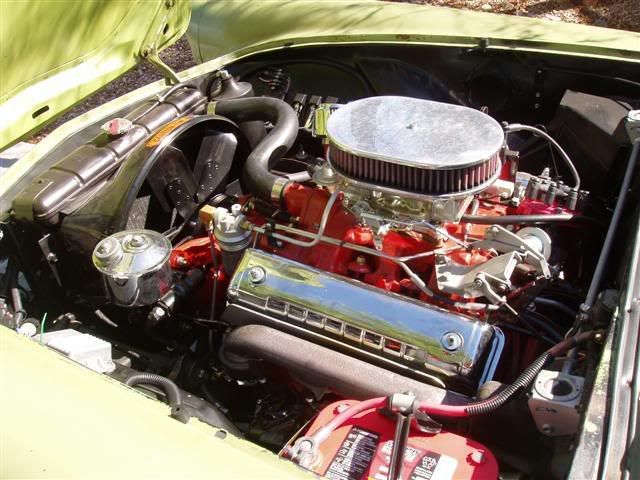
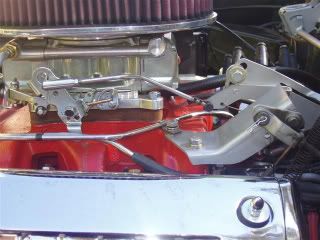
this is with the old 600 Holley - but shows the filter and pressure gauge 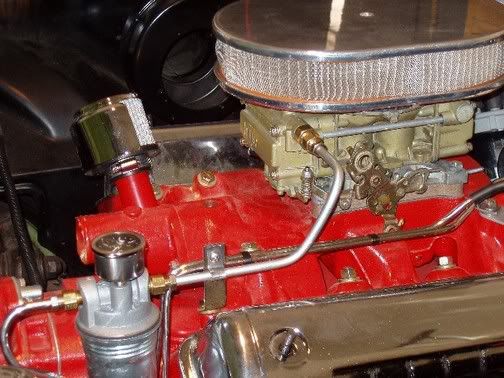
I put a bigger 428 fuel pump on there - with no vacuum pump so that part of the plumbing changed 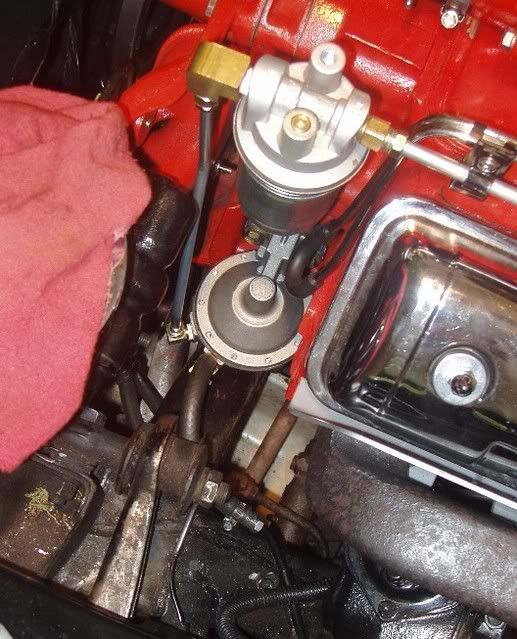
|
|
By GREENBIRD56 - 15 Years Ago
|
|
Ok - so now that the photos will up-load.....for tuning - I will explain - I usually make my outfits run lean and work up from there....others have their way I have mine. The tuning has to match the dizzy - so get your curve in there first. I used 10° static / 26° centrifugal / all in by 2600 rpm. I use live manifold vacuum advance at idle - some don't - but disconnect and plug to set timing. Set idle mixture with vacuum gauge - I think its best not to have the open style of carb spacer on a street motor - so it will "answer" the screws side for side. I used the Holley "Black" secondary spring - stiffest in the pile. The Demon primary is a huge hole with nice boosters and from what I can see - tends to act like a big two barrel most of the time. It doesn't even need the seccondaries to feed a 312 with standard gearing for most use. Primary jets went down one - needle and seat set-up as above. The float level on a Demon is a wonderful tool - it changes rich/lean very nearly linear across the scale. Because the bird auto starts in second - you've got to creep it up until she accelerates cleanly - otherwise bogs a bit.
|
|
By BrianL - 15 Years Ago
|
|
Great photos & thanks again for the tips. Very clean looking. I guess I have to break open the carb to be sure, but believe iI read in searches it comes with #58 primary jets out of the box. I also would like to start a bit lean & go from there. Was that your experience also? Did you try the ported & full vacuum ports for the dizzy & decided it ran better staying with full?
|
|
By GREENBIRD56 - 15 Years Ago
|
|
My experience - starts at '64 in high school - has always been to run them with live manifold vacuum at idle. Ford supplied them with ported and some like that set-up. Ted for instance... The live vacuum makes the idle speed come up - but the idle water temp goes down. It also provides for some very high vacuum readings at idle - that you won't get when you are hooked up to the ported. Wise men have told me - whatever works best for you - use. Keep in mind that when the engine comes off idle - both systems will behave the same........ Running live manifold vacuum and no exhaust crossover valve has made my outfit run pretty cool - in fact I'm about to go up to the 180° thermostat (factory spec is 157°). I don't like the wide swing from winter to summer and I'm trying to narrow it down.
|
|
By aussiebill - 15 Years Ago
|
|
Hi steve, thats a pretty engine bay! and the fuel line plumbing is nice and exact, a credit to you! I couldnt help notice the control arm bush looking ready for replacement next, i guess most of you guys only get to use your cars part way through the year due to the weather if you want to keep them in good condition and major work is done then. We are fortunate with the weather other than some random flooding in areas and extreme heat and no snow that lets us use thm regularly. Steve, i enjoy your knowledge bank on the electrical side of things and is great reference for all of us. Oh! its raining, Best regards bill.
|
|
By GREENBIRD56 - 15 Years Ago
|
|
Captured me - yes, Bill the left upper A-arm bushings are ready for the "last round-up" - and there is another set of arms waiting in the wings with some brake parts - but I'm still missing quite a few items before I just clean out the whole front end mess and start over. Screw-in Chrysler ball joints are done, new anti-dive upper pivot shaft (almost done), aluminum calipers, discs, etc. "As ye go - so must ye stop" Brian - Bend some nice lines for your fuel set-up - its time well spent. I found that a lot of the brass fittings are poorly ported on the inside and had to (judiciously) drill out bigger passages for fuel to flow through. On the pressure side of the pump, it isn't as critical as the suction side. I don't have pictures of it - and its not on the car right now - but I've been trying to design and build a clamp on extension for the lever where the kickdown rod attaches to the linkage. By making the lever longer it should be able to operate the kickdown pressure control rod - to move it downward a bit more than where its stopped now. The "springy" throttle linkage has given me more than a few headaches -and they ain't over yet.
|
|
By aussiebill - 15 Years Ago
|
|
Steve, whats the background of the chrysler ball joints, are they aftermarket arms or adaption of those BJ,s onto orig arms? Curious! thanks. regards bill.
|
|
By BrianL - 15 Years Ago
|
|
Thanks Steve - Did you drop the primary jet numbers from #58 to a #57 or #56? I may attempt to bend some tube & see how that goes. I also am intrigued about your comments on running cooler. I would like some of that.
|
|
By charliemccraney - 15 Years Ago
|
|
BrianL (1/3/2010)
I may attempt to bend some tube & see how that goes.
Do it. With some practice you'll be bending like a pro. There is a lever type bender which can be purchased at Home Depot, Lowes, Sears, and other hardware stores. Actually, you might find better versions at smaller hardware stores. All do a good job. Stay away from the plier type and the el cheapo that you just hook into one end and bend around by hand. Actually, the plier type makes a decent bend it just doesn't make much of a bend.
I like the rolling tubing bender sold by Eastwood. I usually alternate between a lever type and rolling type. My Lever type can make a tighter radius which sometimes comes in handy. The rolling type requires less effort to bend the tubing. Both provide bends very close in quality.
Rolling bender:

Lever type:

Plier type:

El Cheapo:
 
|
|
By GREENBIRD56 - 15 Years Ago
|
|
Brian - I didn't note the new primary jet size I used on paper some where (bad move - don't do this) - but there were a set of #56's in my stash and they are gone. Because there are some new #58's stored in there now - probably answers the question. That's two sizes down..... Be careful closing the hood on the Demon if you use the factory style air-cleaner - I never tried to use that part, just fitted the aftermarket open element style units. The small oval style fits the bump in the hood perfectly - but you may have to adjust your "steady rests" to center the carb/engine under the scoop. It was leaning one way about a half inch...... 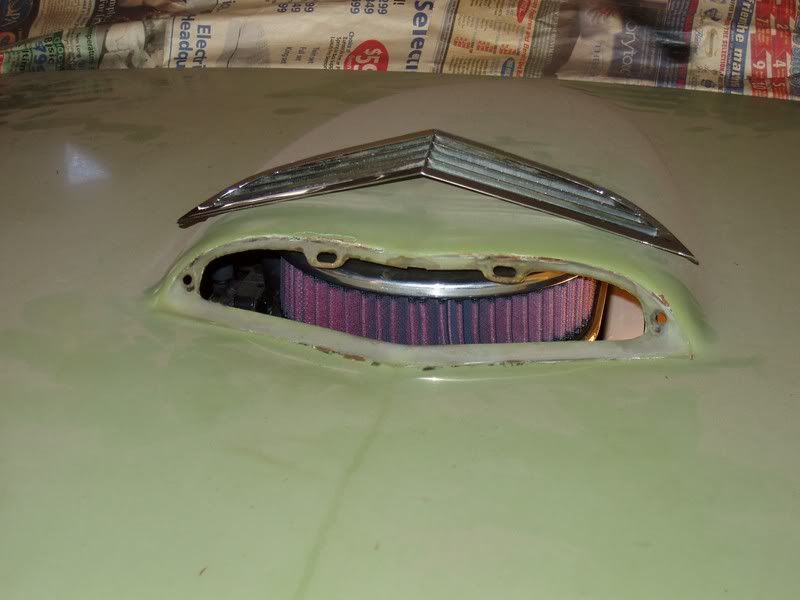
|
|
By 46yblock - 15 Years Ago
|
Regarding carbs...I finally bit a bullet, chipped my teeth, and bought a nice 4100. Stamped number is 6ZA, meaning 66 Mustang 289 manual shift. Kind of been looking for 4 years, so there will be another fun thing to look forward to this spring  . I figured with Ted's dyno tests and some of the proven good things the 4100s offer our engines, better get one before they become even more popular. . I figured with Ted's dyno tests and some of the proven good things the 4100s offer our engines, better get one before they become even more popular.
|
|
By BrianL - 15 Years Ago
|
|
In hooking up the vacuum line to the top of the fuel pump, does it matter if it goes to a ported or non ported source? I already converted the wipers to 12V.
|
|
By Ol'ford nut - 15 Years Ago
|
|
If you have electric wipers you don't have to hook up the vacuum hoses, or need a pump with the vacuum pump on top. The hoses are suppose to go to the intake manifold and the other to the hose going into the firewall. Neither one goes to the carb.
|
|
By BrianL - 15 Years Ago
|
|
So direct from the fuel pump to the manifold would be non-ported vaccum. What is the purpose of the vac line to the fuel pump? It regulates volume?
|
|
By Hoosier Hurricane - 15 Years Ago
|
|
That was a vacuum booster for the windshield wipers. Those of us old enough remember vacuum wipers that slowed down when you accelerated. Not good for passing. If you have converted to electric wipers, you don't need the vacuum lines. A short loop of hose from one fitting to the other will keep dirt out.
|
|
By BrianL - 15 Years Ago
|
|
I remember the wipers slowing down & that's why I converted to 12V later. Thanks for the tip on the short tube to keep the dirt out. I have extra vacuum caps, so I suppose those would work too.
|
|
By marvh - 15 Years Ago
|
|
BrianL (1/6/2010)
I remember the wipers slowing down & that's why I converted to 12V later. Thanks for the tip on the short tube to keep the dirt out. I have extra vacuum caps, so I suppose those would work too.
Another reason you want to hook the hose in a loop is to keep the fuel pump top diaphragm (wiper diaphragm) in a neutral mode otherwise it will be placing extra wear load on the fuel pump eccentric cam and pump arm. When the hose is hooked in a loop it acts same as the fuel pump diaphragm in only pumping if required if fuel pressure is not met. If hose is looped vacuum is met and there is no requirement for top diaphragm to pump.
Leaving the top diaphragm in a working mode wears out the fuel pump cam very quickly.
|
|
By BrianL - 15 Years Ago
|
|
Ah... Great point & makes sense. I will follow the vacuum neutral suggestion. Thanks!
|